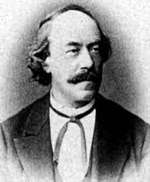Rudolf Lipschitz
Rudolf Otto Sigismund Lipschitz (14 May 1832 – 7 October 1903) was a German mathematician who made contributions to mathematical analysis (where he gave his name to the Lipschitz continuity condition) and differential geometry, as well as number theory, algebras with involution and classical mechanics.
Rudolf Lipschitz | |
|---|---|
 Rudolf Lipschitz | |
| Born | 14 May 1832 |
| Died | 7 October 1903 (aged 71) |
| Nationality | Germany |
| Alma mater | University of Königsberg |
| Known for | Lipschitz continuity Lipschitz integral condition Lipschitz quaternion |
| Scientific career | |
| Fields | Mathematics |
| Institutions | University of Bonn |
| Doctoral advisor | Gustav Dirichlet Martin Ohm |
| Doctoral students | Felix Klein |
Biography
Rudolf Lipschitz was born on 14 May 1832 in Königsberg. He was the son of a landowner and was raised at his father's estate at Bönkein which was near Königsberg.[1] He entered the University of Königsberg when he was 15, but later moved to the University of Berlin where he studied with Gustav Dirichlet. Despite having his studies delayed by illness, in 1853 Lipschitz graduated with a PhD in Berlin.[2]
After receiving his PhD, Lipschitz started teaching at local Gymnasiums. In 1857 he married Ida Pascha, the daughter of one of the landowners with an estate near to his father's.[1] In 1857 he earned his habilitation at the University of Bonn and remained there as a privatdozent. In 1862 Lipschitz became an extraordinary professor at the University of Breslau where he spent the following two years. In 1864 Lipschitz moved back to Bonn as a full professor, remaining there for the rest of his career. Here he examined the dissertation of Felix Klein. Lipschitz died on 7 October 1903 in Bonn.[3]
Rediscovery of Clifford algebra
Lipschitz discovered Clifford algebras in 1880,[4][5] two years after William K. Clifford (1845–1879) and independently of him, and he was the first to use them in the study of orthogonal transformations. Up to 1950 people mentioned "Clifford–Lipschitz numbers" when they referred to this discovery of Lipschitz. Yet Lipschitz's name suddenly disappeared from the publications involving Clifford algebras; for instance Claude Chevalley (1909–1984)[6] gave the name "Clifford group" to an object that is never mentioned in Clifford's works, but stems from Lipschitz's. Pertti Lounesto (1945–2002) contributed greatly to recalling the importance of Lipschitz's role.[7][8]
Selected publications
Lehrbuch der Analysis (two volumes, Bonn 1877, 1880); Wissenschaft und Staat (Bonn, 1874); Untersuchungen über die Summen von Quadraten (Bonn, 1886); Bedeutung der theoretischen Mechanik (Berlin, 1876).
See also
References
- http://www-history.mcs.st-andrews.ac.uk/Biographies/Lipschitz.html
- McElroy, Tucker (2009). A to Z of Mathematicians. Infobase Publishing. p. 176. ISBN 978-1-438-10921-3.
- Chang, Sooyoung (2011). Academic Genealogy of Mathematicians. World Scientific. p. 27. ISBN 978-9-814-28229-1.
- R. Lipschitz (1880). "Principes d'un calcul algébrique qui contient comme espèces particulières le calcul des quantités imaginaires et des quaternions". C. R. Acad. Sci. Paris. 91: 619–621, 660–664.
- R. Lipschitz (signed) (1959). "Correspondence". Ann. of Math. 69 (1): 247–251. doi:10.2307/1970102.
- Chevalley, Claude (1997). The Algebraic Theory of Spinors and Clifford Algebras (Collected Works Vol. 2 ed.). Springer-Verlag. pp. 48, 113. ISBN 978-3-540-57063-9.
- Lounesto, Pertti (1997). Clifford Algebras and Spinors. Cambridge University Press. p. 220. ISBN 978-0-521-59916-0.
- Jacques Helmstetter, Artibano Micali: Quadratic Mappings and Clifford Algebras, Birkhäuser, 2008, ISBN 978-3-7643-8605-4 Introduction, p. ix ff.
External links
- O'Connor, John J.; Robertson, Edmund F., "Rudolf Lipschitz", MacTutor History of Mathematics archive, University of St Andrews.
- Rudolf Lipschitz at the Mathematics Genealogy Project
- H. Kortum. "1903 Obituary". In Jahresbericht DMV 16. pp. 56–59. Retrieved 16 July 2006. (digitalized document, provided without fee by Göttingen Digitalization Project, in German)